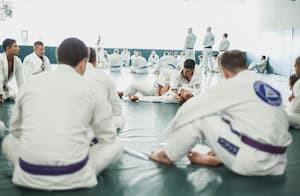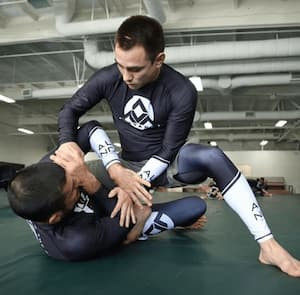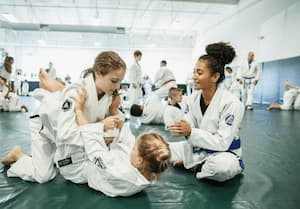BJJ Classes in NYC

Brazilian Jiu-Jitsu classes in NYC are typically designed to introduce individuals who are new to BJJ the fundamentals of the fighting style. Whereas BJJ training is often more conceptual, beginning BJJ classes are more tangible and structured. They typically only last one hour and focus on teaching specific moves and techniques before allowing students to grapple and spar so that they can practice what they have just learned.
In many cases, a typical white belt (beginner level) BJJ class in NYC will follow a structure like this:
- 10-15 minutes Warm-up: Cardiovascular, Calisthenics and Sport Specific Movement Drills.
- 10 minutes: Students are taught a technique.
- 10-15 minutes: Students practice with a partner.
- 10 minutes: Students are taught another technique.
- 10-15 minutes: Students practice with a partner.
For more advanced students, the typical BJJ class format may look something like the following:
- 10 minutes Warm-up: Cardiovascular, Calisthenics and Sport Specific Movement Drills.
- 15 minutes: Students are taught a technique and drill on one another
- 15 minutes: Isolated sparring to drill the technique with a resisting partner.
- 20 minutes: Sparring/Rolling Session.
For practitioners who are training to be in competitions, classes may extend for longer periods of time or a separate training session would be created to specifically adjust to competition format and rules. Competition training can go upwards of 90 minutes. These classes are typically not focused on growth, but on perfecting methods to win competitions.
Gi Class
Students wear a BJJ uniform, called a Gi, and is common to most typical Brazilian Jiu Jitsu Academies. The Gi is a traditional Japanese Jiu Jitsu uniform which consists of a Heavy Cotton Jacket, drawstring pants, and a belt that denotes rank. Typically, a Rash guard or T-shirt is worn underneath the Gi. Wearing a Gi is not only a part of tradition; it also serves as a very important training tool. The purpose of the Gi is to allow the practitioners the ability to use technique to break free from their opponents grip on their Gi; separately, it allows the gripping opponent to slow down the pace of the fight so that a more technical sparring session may ensue. The Gi simply evens the playing field between the athletically gifted and the less athletic practitioner – thus allowing both players to apply sound technique to either defend or attack during a sparring session. Giving equal opportunity to both practitioners to employ their Jiu Jitsu tactics.
Submission Wrestling Class (aka No-Gi Class)

It is not uncommon for BJJ Academies to incorporate a No-Gi class into their educational curriculum. No-Gi classes are typically offered to intermediate to advanced level students who have a solid grasp of fundamental BJJ techniques and concepts. The student participants typically wear a Rash guard and Board Shorts (i.e. a form fitting sweat wicking material). In this class, the submissions and grips are limited. Athleticism and conditioning become a factor and the pace of the sparring match is significantly faster. Matches between opponents shift from a slow, methodical pace (Gi) to a fast and reactionary pace (No-Gi).
Gracie University Classes
Gracie University BJJ class formats are distinct from typical BJJ classes in NYC because Gracie classes typically maintain a self-defense mindset rather than solely grappling competition. While Gracie Jiu Jitsu® practitioners enjoy competition from time-to-time. They understand that Gracie Jiu Jitsu has more depth and dimensions to Jiu Jitsu than just winning a grappling competition. There are specific types of Gracie classes that are designed to teach different skills and principles. For example, there are Bullyproof Classes, which empower kids by teaching them street smarts, how to protect themselves in dangerous situations, and how to deter and neutralize bullies.  The Women Empowered program, where they empower women by teaching them the psychology of an assault, which teaches them to lessen their chances of being victimized. They’re also taught self-defense techniques that scale from an uncomfortable flirting scenario to an assault by a stranger. And finally, you have the Master Cycle® where a student can delve deeper into Jiu Jitsu techniques learning advanced submission moves and sparring with other members of their class.
The Women Empowered program, where they empower women by teaching them the psychology of an assault, which teaches them to lessen their chances of being victimized. They’re also taught self-defense techniques that scale from an uncomfortable flirting scenario to an assault by a stranger. And finally, you have the Master Cycle® where a student can delve deeper into Jiu Jitsu techniques learning advanced submission moves and sparring with other members of their class.
While the techniques taught and employed by Gracie Jiu Jitsu practitioners are the same as those from most other BJJ Academies, the context to which they are taught and the principles behind the applications is the main differentiator.
Each training session is not merely about submitting your opponent within a predetermined time limit, but also learning how to endure a challenging position, being patient in waiting for the right opportunity to respond and contributing to a cooperative training environment that will allow both practitioners many chances to iterate these scenarios, so as to help one another evolve their overall development.
This Certified Gracie Jiu-Jitsu Training Center is independently owned and operated. Gracie Jiu-Jitsu®, Gracie Combatives®, Gracie Bullyproof®, Women Empowered®, and Certified Gracie Jiu-Jitsu Training Center®, are registered trademarks used under license from Gracie University.
Faq
How many calories do your burn training Jiu Jitsu?
Jiu-Jitsu practice is typically comprised of warm up drills, technique drilling, and scenario or full sparring (wrestling) while these individual activities vary from mild to average to intense output, respectively,, even among these sub-sects of training the intensity may vary … for example, you can ramp up the intensity of a warm up drill (like sprawls, which resemble “burpees”) and make it a high intensity work out. Conversely, what is typically looked upon as the most intense iteration of training, “rolling”, can be done in a smoother, slower, more technical pace if both players are seasoned and mature enough to train at the same pace and often times put a competitive mindset on the side lines. That said, the actual numbers are a mean average of anywhere from 450 calories to 750 calories.
Is Jiu Jitsu safe?
Jiu-Jitsu can be practiced safely if all participants agree to make their partners safety the most important element of their training modalities, this should also trump any competitive goals – especially when it comes to live grappling with certain dangerous submission holds. Also, if the practice of takedowns is closely monitored with the appropriate safety guidelines in place, then the risk of preventable injuries can be massively curtailed.
Is Jiu Jitsu a good workout?
Jiu-Jitsu practice is typically comprised of warm up drills, technique drilling, and scenario or full sparring (wrestling) while these individual activities vary from mild to average to intense output, respectively,, even among these sub-sects of training the intensity may vary … for example, you can ramp up the intensity of a warm up drill (like sprawls, which resemble “burpees”) and make it a high intensity work out. Conversely, what is typically looked upon as the most intense iteration of training, “rolling”, can be done in a smoother, slower, more technical pace if both players are seasoned and mature enough to train at the same pace and often times put a competitive mindset on the side lines. That said, the actual numbers are a mean average of anywhere from 450 calories to 750 calories.
Why train BJJ?
Training in BJJ is empowering. It is the only martial art that allows the practioner to safely experience mental, emotional and physical pressure in a controlled environment. The practice of Jiu Jitsu allows safe iterations needed to improve on their last response to this pressure. Constantly improving their response and eventually elevating their skills and confidence both on and off the mat.
What should I wear to my first class?
Gracie Jiu Jitsu relies on the use of a Jiu Jitsu Gi, not merely as a uniform, but a training tool to place both athletic and non-athletic practioners on equal footing. The Gi, allows for 'handles' on collars, lapels and sleeves to slow the pace of the practice and focus more on technical responses rather than athletics bursts of strength during a sparring session.

